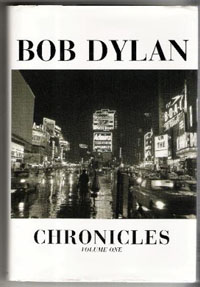Here’s an essay by Scott Warmuth for New Haven Review regarding Dylan’s hidden charlatanism subtext in Chronicles: Volume One
Bob Charlatan
Deconstructing Dylan’s Chronicles: Volume One
by Scott Warmuth
New Haven Review
The world luvs to be cheated, but they want to hav it dun bi an honest man, and not bi a hornet and then they never seem to git tired ov it.
“”Josh Billings
 When Bob Dylan”™s memoir Chronicles: Volume One
When Bob Dylan”™s memoir Chronicles: Volume One was released in 2004 it received overwhelmingly positive reviews. Dylan”™s recollections came off as disarmingly personal; the use of language in his prose was said to be as distinctive and captivating as it is in his songs. But over the past several years, in loose collaboration with Edward Cook, of Washington, DC, I have been giving Chronicles a closer look. Ed is, among other things, an editor of The Dead Sea Scrolls: A New Translation“”deciphering and translating are his business””but he is also a Bob Dylan fan and blogger. In 2006, he first posted about borrowings in Chronicles: Volume One from Mark Twain, Marcel Proust, and jazzman Mezz Mezzrow”™s 1946 autobiography Really the Blues; later he posted about borrowings from Jack London and even Sax Rohmer, creator of Dr. Fu Manchu. And together Ed and I have found in Chronicles an author, Bob Dylan, who has embraced camouflage to an astounding degree, in a book that is meticulously fabricated, with one surface concealing another, from cover to cover.
Dozens upon dozens of quotations and anecdotes have been incorporated from other sources. Dylan has hidden many puzzles, jokes, secret messages, secondary meanings, and bizarre subtexts in his book. After many months of research my copy of Chronicles: Volume One is drenched in highlighter and filled with marginalia and I have a thigh-high stack of books, short stories, and periodicals that Dylan drew from to work his autobiographical alchemy.
To wit: Dylan borrows from American classics and travel guides, fiction and nonfiction about the Civil War, science fiction, crime novels, both Thomas Wolfe and Tom Wolfe, Hemingway, books on photography, songwriting, Irish music, soul music, and a book about the art of the sideshow banner. He dipped into both a book favored by a nineteenth-century occult society and a book about the Lewinsky scandal by Showgirls screenwriter Joe Eszterhas.
Read the rest of this article here.
Also on the subject of the magic and allure of Bob Dylan: Sean Wilentz’s new book <a href="http://www.amazon.com/gp/product/0385529880?ie=UTF8&tag=pranks-20&linkCode=as2&camp=1789&creative=390957&creativeASIN=0385529880"Bob Dylan In America is out:
 From Amazon.com — Growing up in Greenwich Village, Sean Wilentz discovered the music of Bob Dylan as a young teenager; almost half a century later, he revisits Dylan”™s work with the skills of an eminent American historian as well as the passion of a fan. Drawn in part from Wilentz”™s essays as “historian in residence” of Dylan”™s official website, Dylan in America is a unique blend of fact, interpretation, and affinity””a book that, much like its subject, shifts gears and changes shape as the occasion warrants.
From Amazon.com — Growing up in Greenwich Village, Sean Wilentz discovered the music of Bob Dylan as a young teenager; almost half a century later, he revisits Dylan”™s work with the skills of an eminent American historian as well as the passion of a fan. Drawn in part from Wilentz”™s essays as “historian in residence” of Dylan”™s official website, Dylan in America is a unique blend of fact, interpretation, and affinity””a book that, much like its subject, shifts gears and changes shape as the occasion warrants.
Beginning with his explosion onto the scene in 1961, this book follows Dylan as he continues to develop a body of musical and literary work unique in our cultural history. Wilentz”™s approach places Dylan”™s music in the context of its time, including the early influences of Popular Front ideology and Beat aesthetics, and offers a larger critical appreciation of Dylan as both a song writer and performer down to the present. Wilentz has had unprecedented access to studio tapes, recording notes, rare photographs, and other materials, all of which allow him to tell Dylan”™s story and that of such masterpieces as Blonde on Blonde with an unprecedented authenticity and richness.
